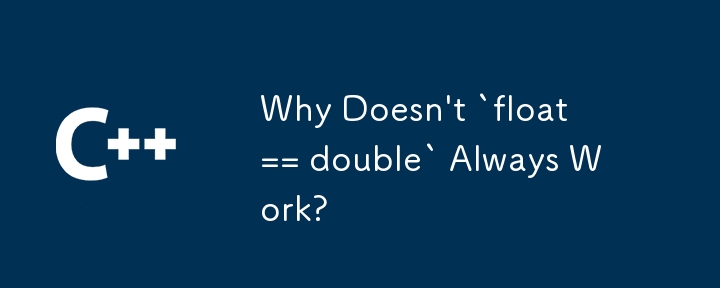

Comparison of Doubles and Floats: Why Unexpected Results?
Floating-point numbers like doubles and floats play a crucial role in numerical computation. However, comparing these types can lead to puzzling results, as illustrated by the code snippet below:
<code class="python">float f = 1.1 double d = 1.1 if (f == d): # returns false!</code>
This unexpected behavior stems from two fundamental factors: precision and rounding.
Precision:
Floating-point numbers have finite precision, which limits the number of digits they can accurately represent. Numbers with higher precision require more memory, which is not always feasible for floating-point variables.
For instance, the fraction 1/3 in decimal (0.33333...) cannot be precisely represented in a 32-bit float. It must be approximated and stored as 0.3333333333333333, resulting in a tiny loss of precision.
Rounding:
Binary and decimal numbers have inherent differences. Fractions that can be easily represented in decimal (e.g., 1/10 as 0.1) often require complex representations in binary (e.g., 1/10 as 0.0001100110011...).
This discrepancy leads to rounding errors, where floating-point values are truncated to fit within the memory limitations. As a result, the representation of 0.1 in the example code may not be exactly equal to 0.1 stored in the double.
Conclusion:
Due to precision and rounding issues, comparing doubles and floats using equality (==) is unreliable. Instead, a more robust approach is to compare their absolute difference to an acceptable epsilon value. This ensures that the difference is within an acceptable tolerance.
<code class="python">if abs(f - d) < epsilon: # epsilon is a small threshold</code>
This approach ensures that the comparison is not affected by precision and rounding errors, leading to accurate and consistent results.
The above is the detailed content of Why Doesn\'t `float == double` Always Work?. For more information, please follow other related articles on the PHP Chinese website!
 vim save and exit command
vim save and exit command
 How to set path environment variable
How to set path environment variable
 Mysql database migration method
Mysql database migration method
 C++ software Chinese change tutorial
C++ software Chinese change tutorial
 The difference between rest api and api
The difference between rest api and api
 How to use mysql workbench
How to use mysql workbench
 How to use nanosleep function
How to use nanosleep function
 What are the methods for restarting applications in Android?
What are the methods for restarting applications in Android?
 transactionscope usage
transactionscope usage




